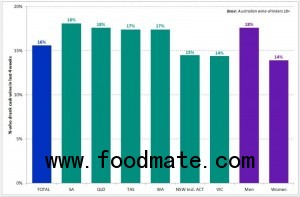Considering that a South Australian invented the wine cask, it seems fitting that wine drinkers from SA are more likely than those from other states to enjoy their vino from a box: 18% drink cask wine in an average four weeks, just ahead of Queensland (a smidgen under 18%), Tasmania (17%) and Western Australia (17%).
Whereas the ratio between male and female drinkers is quite even for bottled wine, a noticeably higher proportion of men (18%) drink cask wine than women (14%).
Australia’s cask-wine drinkers by state of residence and gender

Cask vs bottled wine
So what distinguishes a cask-wine drinker from the vast bottled-wine quaffing majority?
For starters, cask wine is especially popular among older Australians. People aged 65+ are almost 60% more likely to go for goon than the average wine drinker. At the opposite end of the age spectrum, 18-24 year-olds are also more likely to drink it (in striking contrast to 25-34 year-olds, among whom cask-wine drinking is well below average).
Of course, the affordability of cask wine would boost its appeal to both groups: while many in the younger group are still studying or in the early stages of their careers (with salaries to match), the 65+ bracket includes many retirees living on pensions.
In fact, affordability appears to be one of cask wine’s biggest selling points. For example, 26% of wine-drinkers from the cash-strapped FG socio-economic quintile and 24% of those from the budget-bound E quintile opt for cask wine, compared with just 8% of people from the most affluent AB quintile.
“Since South Australian winemaker Thomas Angove invented cask wine packaging in 1965, the ‘plastic bladder in a cardboard box’ has become a worldwide phenomenon, said Andrew Price, General Manager – Consumer Products,Roy Morgan Research. “However, it seems cask wine’s glory days could be over, as there has been a substantial decline in the number of Aussies drinking it over the last few years.”
“Whether this downward trend is simply a symptom of the more widespread decrease in wine-drinking in Australia, or the result of competition from a myriad of cheap bottled wines now available, is hard to know,” said Price.
“What is certain, however, is that winemakers who produce a cask range need to have a detailed knowledge of the demographics, attitudes and habits of their target market so they can tailor their communications accordingly and expand their customer base as a result.”
So what distinguishes a cask-wine drinker from the vast bottled-wine quaffing majority?
For starters, cask wine is especially popular among older Australians. People aged 65+ are almost 60% more likely to go for goon than the average wine drinker. At the opposite end of the age spectrum, 18-24 year-olds are also more likely to drink it (in striking contrast to 25-34 year-olds, among whom cask-wine drinking is well below average).
Of course, the affordability of cask wine would boost its appeal to both groups: while many in the younger group are still studying or in the early stages of their careers (with salaries to match), the 65+ bracket includes many retirees living on pensions.
In fact, affordability appears to be one of cask wine’s biggest selling points. For example, 26% of wine-drinkers from the cash-strapped FG socio-economic quintile and 24% of those from the budget-bound E quintile opt for cask wine, compared with just 8% of people from the most affluent AB quintile.
“Since South Australian winemaker Thomas Angove invented cask wine packaging in 1965, the ‘plastic bladder in a cardboard box’ has become a worldwide phenomenon, said Andrew Price, General Manager – Consumer Products,Roy Morgan Research. “However, it seems cask wine’s glory days could be over, as there has been a substantial decline in the number of Aussies drinking it over the last few years.”
“Whether this downward trend is simply a symptom of the more widespread decrease in wine-drinking in Australia, or the result of competition from a myriad of cheap bottled wines now available, is hard to know,” said Price.
“What is certain, however, is that winemakers who produce a cask range need to have a detailed knowledge of the demographics, attitudes and habits of their target market so they can tailor their communications accordingly and expand their customer base as a result.”





